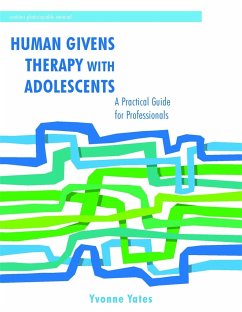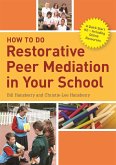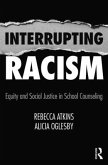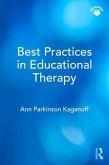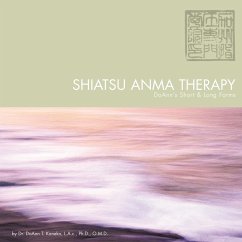- Broschiertes Buch
- Merkliste
- Auf die Merkliste
- Bewerten Bewerten
- Teilen
- Produkt teilen
- Produkterinnerung
- Produkterinnerung
This resource offers an essential insight into the emotional well-being of adolescents and a detailed overview of the Human Givens approach. The book provides useful assessment tools and practical interventions, all supported by photocopiable materials that include question sheets for the client and record charts for the practitioner.
Andere Kunden interessierten sich auch für
![Virtual Educational Therapy Virtual Educational Therapy]() Marion E. MarshallVirtual Educational Therapy31,99 €
Marion E. MarshallVirtual Educational Therapy31,99 €![Metaphors in Counselor Education and Supervision Metaphors in Counselor Education and Supervision]() Metaphors in Counselor Education and Supervision51,99 €
Metaphors in Counselor Education and Supervision51,99 €![How to Do Restorative Peer Mediation in Your School How to Do Restorative Peer Mediation in Your School]() Bill HansberryHow to Do Restorative Peer Mediation in Your School51,99 €
Bill HansberryHow to Do Restorative Peer Mediation in Your School51,99 €![Interrupting Racism Interrupting Racism]() Rebecca AtkinsInterrupting Racism54,99 €
Rebecca AtkinsInterrupting Racism54,99 €![Best Practices in Educational Therapy Best Practices in Educational Therapy]() Ann Parkinson KaganoffBest Practices in Educational Therapy59,99 €
Ann Parkinson KaganoffBest Practices in Educational Therapy59,99 €![Internationalizing US Student Affairs Practice Internationalizing US Student Affairs Practice]() Tamara YakaboskiInternationalizing US Student Affairs Practice52,99 €
Tamara YakaboskiInternationalizing US Student Affairs Practice52,99 €![Shiatsu Anma Therapy Doann's Short & Long Forms Shiatsu Anma Therapy Doann's Short & Long Forms]() DoAnn T. Kaneko L. A. c. O. M. D.Shiatsu Anma Therapy Doann's Short & Long Forms99,99 €
DoAnn T. Kaneko L. A. c. O. M. D.Shiatsu Anma Therapy Doann's Short & Long Forms99,99 €-
-
-
This resource offers an essential insight into the emotional well-being of adolescents and a detailed overview of the Human Givens approach. The book provides useful assessment tools and practical interventions, all supported by photocopiable materials that include question sheets for the client and record charts for the practitioner.
Hinweis: Dieser Artikel kann nur an eine deutsche Lieferadresse ausgeliefert werden.
Hinweis: Dieser Artikel kann nur an eine deutsche Lieferadresse ausgeliefert werden.
Produktdetails
- Produktdetails
- Verlag: Jessica Kingsley Publishers
- Seitenzahl: 192
- Erscheinungstermin: 15. Januar 2011
- Englisch
- Abmessung: 277mm x 213mm x 15mm
- Gewicht: 499g
- ISBN-13: 9781849051705
- ISBN-10: 1849051704
- Artikelnr.: 31757654
- Herstellerkennzeichnung
- Libri GmbH
- Europaallee 1
- 36244 Bad Hersfeld
- 06621 890
- Verlag: Jessica Kingsley Publishers
- Seitenzahl: 192
- Erscheinungstermin: 15. Januar 2011
- Englisch
- Abmessung: 277mm x 213mm x 15mm
- Gewicht: 499g
- ISBN-13: 9781849051705
- ISBN-10: 1849051704
- Artikelnr.: 31757654
- Herstellerkennzeichnung
- Libri GmbH
- Europaallee 1
- 36244 Bad Hersfeld
- 06621 890
Yvonne Yates
Preface. About this Book. Part 1. 1. Adolescents and Emotional Well-Being.
Organizational interest. Prevalence. Adolescents: A special population.
Experiences posing a threat to development. Trauma. Adolescents and coping
strategies. Therapy and adolescents: What works? Mediators of change. Human
givens therapy with adolescents. Therapy in schools. Therapy in other
settings. Supervision and competence in delivering therapies. 2. The Human
Givens Approach. The values, principles and goals of human givens therapy.
Human givens needs. Human givens resources. Distinctiveness and promising
contributions of human givens therapy. Order of events in brain
functioning. Human givens therapy and its use with adolescents. Explaining
therapeutic models to young people. RIGAAR: The application of the human
givens approach by professionals. Influence of psychological paradigms on
human givens therapy. Human givens therapy: Evidence base. Studies
involving human givens therapy. Training in human givens therapy.
Evaluating human givens. Part 2. 3. Assessment in Human Givens Therapeutic
Approaches. Assessment procedure: Identifying and recording needs.
Assessment and identification of human givens needs. Connection to others.
Connection to the wider community. Connection - friendships. Attention -
giving and receiving. Achievement and competence. Autonomy and control.
Privacy. Purpose and meaning. Security - feeling safe. Status. Other
information to record. Assessment of severity of emotional symptoms.
Assessment of life satisfaction and the LSS. LSS administration.
Checkpoint. Part 3. 4. Intervention Structure. Recording information during
contact with the young person. Introduction. The RIGAAR model: Structuring
interventions. Interventions based on other therapies. APET and human
givens interventions. Separating the person from the problem: Replacing
anxiety with humour. 5. Interventions for Each of the Human Givens Needs.
Introduction. Beyond the therapy room. Interventions according to human
givens needs. 6. Laura. Introduction. Record of sessions. Post-therapy
scores. How did human givens therapy increase Laura's emotional well-being?
References.
Organizational interest. Prevalence. Adolescents: A special population.
Experiences posing a threat to development. Trauma. Adolescents and coping
strategies. Therapy and adolescents: What works? Mediators of change. Human
givens therapy with adolescents. Therapy in schools. Therapy in other
settings. Supervision and competence in delivering therapies. 2. The Human
Givens Approach. The values, principles and goals of human givens therapy.
Human givens needs. Human givens resources. Distinctiveness and promising
contributions of human givens therapy. Order of events in brain
functioning. Human givens therapy and its use with adolescents. Explaining
therapeutic models to young people. RIGAAR: The application of the human
givens approach by professionals. Influence of psychological paradigms on
human givens therapy. Human givens therapy: Evidence base. Studies
involving human givens therapy. Training in human givens therapy.
Evaluating human givens. Part 2. 3. Assessment in Human Givens Therapeutic
Approaches. Assessment procedure: Identifying and recording needs.
Assessment and identification of human givens needs. Connection to others.
Connection to the wider community. Connection - friendships. Attention -
giving and receiving. Achievement and competence. Autonomy and control.
Privacy. Purpose and meaning. Security - feeling safe. Status. Other
information to record. Assessment of severity of emotional symptoms.
Assessment of life satisfaction and the LSS. LSS administration.
Checkpoint. Part 3. 4. Intervention Structure. Recording information during
contact with the young person. Introduction. The RIGAAR model: Structuring
interventions. Interventions based on other therapies. APET and human
givens interventions. Separating the person from the problem: Replacing
anxiety with humour. 5. Interventions for Each of the Human Givens Needs.
Introduction. Beyond the therapy room. Interventions according to human
givens needs. 6. Laura. Introduction. Record of sessions. Post-therapy
scores. How did human givens therapy increase Laura's emotional well-being?
References.
Preface. About this Book. Part 1. 1. Adolescents and Emotional Well-Being.
Organizational interest. Prevalence. Adolescents: A special population.
Experiences posing a threat to development. Trauma. Adolescents and coping
strategies. Therapy and adolescents: What works? Mediators of change. Human
givens therapy with adolescents. Therapy in schools. Therapy in other
settings. Supervision and competence in delivering therapies. 2. The Human
Givens Approach. The values, principles and goals of human givens therapy.
Human givens needs. Human givens resources. Distinctiveness and promising
contributions of human givens therapy. Order of events in brain
functioning. Human givens therapy and its use with adolescents. Explaining
therapeutic models to young people. RIGAAR: The application of the human
givens approach by professionals. Influence of psychological paradigms on
human givens therapy. Human givens therapy: Evidence base. Studies
involving human givens therapy. Training in human givens therapy.
Evaluating human givens. Part 2. 3. Assessment in Human Givens Therapeutic
Approaches. Assessment procedure: Identifying and recording needs.
Assessment and identification of human givens needs. Connection to others.
Connection to the wider community. Connection - friendships. Attention -
giving and receiving. Achievement and competence. Autonomy and control.
Privacy. Purpose and meaning. Security - feeling safe. Status. Other
information to record. Assessment of severity of emotional symptoms.
Assessment of life satisfaction and the LSS. LSS administration.
Checkpoint. Part 3. 4. Intervention Structure. Recording information during
contact with the young person. Introduction. The RIGAAR model: Structuring
interventions. Interventions based on other therapies. APET and human
givens interventions. Separating the person from the problem: Replacing
anxiety with humour. 5. Interventions for Each of the Human Givens Needs.
Introduction. Beyond the therapy room. Interventions according to human
givens needs. 6. Laura. Introduction. Record of sessions. Post-therapy
scores. How did human givens therapy increase Laura's emotional well-being?
References.
Organizational interest. Prevalence. Adolescents: A special population.
Experiences posing a threat to development. Trauma. Adolescents and coping
strategies. Therapy and adolescents: What works? Mediators of change. Human
givens therapy with adolescents. Therapy in schools. Therapy in other
settings. Supervision and competence in delivering therapies. 2. The Human
Givens Approach. The values, principles and goals of human givens therapy.
Human givens needs. Human givens resources. Distinctiveness and promising
contributions of human givens therapy. Order of events in brain
functioning. Human givens therapy and its use with adolescents. Explaining
therapeutic models to young people. RIGAAR: The application of the human
givens approach by professionals. Influence of psychological paradigms on
human givens therapy. Human givens therapy: Evidence base. Studies
involving human givens therapy. Training in human givens therapy.
Evaluating human givens. Part 2. 3. Assessment in Human Givens Therapeutic
Approaches. Assessment procedure: Identifying and recording needs.
Assessment and identification of human givens needs. Connection to others.
Connection to the wider community. Connection - friendships. Attention -
giving and receiving. Achievement and competence. Autonomy and control.
Privacy. Purpose and meaning. Security - feeling safe. Status. Other
information to record. Assessment of severity of emotional symptoms.
Assessment of life satisfaction and the LSS. LSS administration.
Checkpoint. Part 3. 4. Intervention Structure. Recording information during
contact with the young person. Introduction. The RIGAAR model: Structuring
interventions. Interventions based on other therapies. APET and human
givens interventions. Separating the person from the problem: Replacing
anxiety with humour. 5. Interventions for Each of the Human Givens Needs.
Introduction. Beyond the therapy room. Interventions according to human
givens needs. 6. Laura. Introduction. Record of sessions. Post-therapy
scores. How did human givens therapy increase Laura's emotional well-being?
References.

